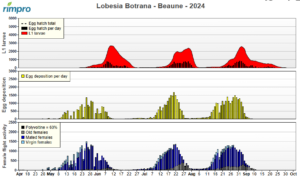European grapevine moth (Lobesia botrana)
Lobesia botrana, or grapevine moth, is a major lepidopteran pest of vineyards, particularly in Europe, North Africa and Western Asia, although it has also been reported in North America.
The video with detailed explanations about the model is available here
The adult is a small butterfly, 6 to 8 mm long, with brownish forewings decorated with dark patterns and lighter hindwings. Its life cycle comprises several stages: egg, larva, pupa and adult, with 2 to 4 generations per year depending on the climate.
The eggs hatch within a few days, and the young larvae begin to feed on flowers or berries. The larvae of the last generation cause the most damage by perforating the berries, encouraging the development of fungal diseases such as botrytis (grey rot).
This pest can cause significant economic losses by affecting the quality and quantity of wine production. Eudemis management is based on integrated methods, including mating disruption, biological treatments (Bacillus thuringiensis) and precise chemical interventions to limit populations and their impact.
The model

The lower graph shows the active flight of female moths.
In spring, the larvae emerge from diapause. The emergence of the first moths depend on temperature and day length. The intensity of flight and mating is calculated on the basis of twilight temperatures and is interrupted during periods of rain. Sexual confusion (if used by the wine grower) must be installed before the start of the flight. If you trap a moth before the model predicts the start of flight, you can enter a biofix in your station parameters and enter your flight start date.
The middle graph shows in yellow the daily egg laying . The flight of females during warm evenings results in high egg laying. Egg development is then calculated as a function of temperature. Optimum development occurs between 25 and 30°C.
The upper graph shows daily hatchings in black (dotted line for cumulative number) as well as the number of ‘L1’ stage larvae. The other larval stages (L2,3,4,5) are not modelled because the larvae are protected in the glomerules (1st generation) or have already penetrated the berries (2nd and subsequent generations) and are therefore less accessible. Most ‘organic’ insecticides are effective on the very first L1 stage larvae.